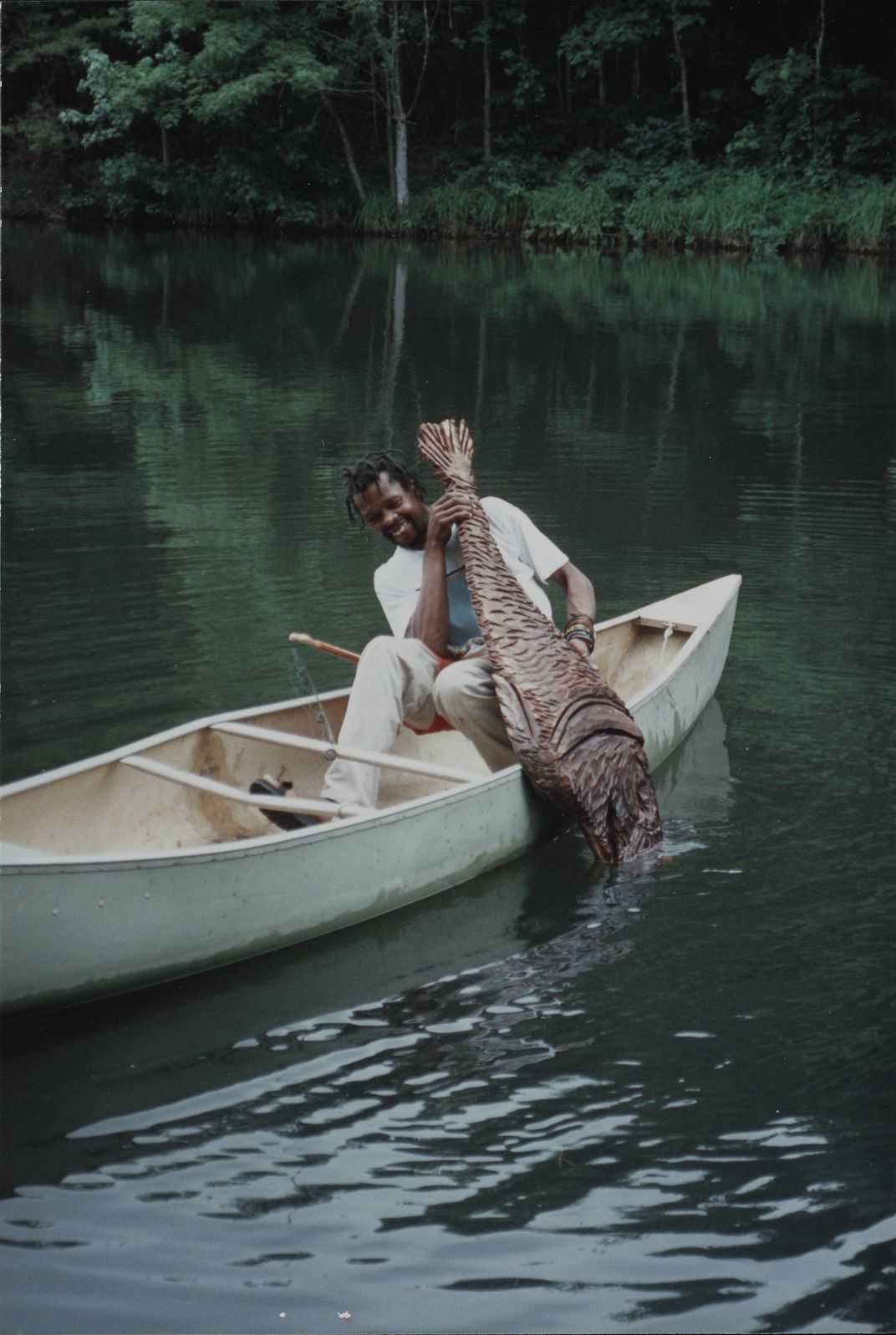Lonnie Holley and the Geologies of Alabama
/https://tf-cmsv2-smithsonianmag-media.s3.amazonaws.com/blogging/featured/AAA_hedgjimm_62544_siv.jpg)
Life never remains the same, so our materials cannot remain the same. I think all artists will agree.
- Lonnie Holley
In a photograph found in the papers of collector and dealer Jimmy Hedges at the Archives of American Art, artist Lonnie Holley (b. 1950) sits in the middle of a forest. Faded gold and russet leaves frame the background, and a jagged outcropping flanks him on either side and below his feet. Closer inspection reveals that these beige and cocoa-colored rocks are actually carved portraits and sculpture made from a sandstone-like material.
Holley first learned to cut this soft stone out of necessity. When two of his nieces were killed tragically in a house fire in 1979, Holley carved their tombstones out of the only material he could find in his hometown of Birmingham, Alabama. This “sandstone” is actually chemically bonded sand made to cast metal pipe—a by-product of the iron and steel industries that thrived in the city until the late twentieth century. Rich in the raw materials to make iron (coal, iron ore, and limestone), Birmingham was founded in 1871 and named for the great manufacturing city of Birmingham, England. By the 1970s, however, the Alabama city’s roaring industrial production was waning. Holley made tombstones and later, sculptures, out of material that itself was an elegy for a lost past.
The same year as his nieces’ death, Holley brought his sculptures to the Birmingham Museum of Art (BMA). They captivated then-director Richard Murray. He shared them with Barbara Shissler Nosanow, a curator at the National Museum of American Art (now the Smithsonian American Art Museum), where they were featured in the 1981 exhibition, More than Land or Sky: Art from Appalachia.
During this period, Holley remained in Birmingham making sculpture. He became a teaching artist, instructing schoolchildren on how to use a file to carve sandstone, eventually earning the moniker, the Sandman. He purchased land in the city to create “one square acre of art” that functioned as part home, part studio, and part environmental installation.

After a dispute with the Birmingham Airport Authority over its expansion into his property, Holley moved to Harpersville, Alabama, a town about 30 miles southeast of Birmingham. It was near here that friend Jimmy Hedges photographed Holley—in a photograph currently on view in the exhibition Off the Beaten Track: A Road Trip through the Archives of American Art—hauling his roughly human-sized sandstone fish out of the river water. One hand supports the back of its scaled body and the other grips its notched tail.
In 1984, the BMA first acquired Holley’s sandstone sculpture with The Mystery of the White in Me. The work is an amalgam of the beige and cocoa-colored sandstone featured in the photograph of Holley in the Alabama woods. Two pieces of pigmented stone carved in undulating vertical bands on one half and a face on the other represent a self-portrait of Holley and his multi-ethnic background. The black and the white remain divided, however—unreconciled but part of the same whole.
Such can also be said of Birmingham’s neighborhoods, which historically (and today) are often divided along racial lines. Holley referenced this division when talking about gathering material for his artworks, which evolved from the cast-off sandstone to cast-off objects. He recalled in his essay, “My name is Lonnie Bradley Holley,”
I find most of my material in the black area of Birmingham, but I also find material outside of the black area. I go into the shopping malls, I go behind the stores, I go into the alleys, I go into the garbage cans, and I go into the neighborhoods and take things that other people throw away.
The BMA’s The Pointer Pointing the Way of Life on Earth, for example, is made from a concrete lawn ornament, cloth, tree limb, dog chain, plastic water bottle, paper, cotton, and polypropylene. Holley references historical symbols of oppression for people of color through his incorporation of a stereotypical lawn jockey and a chain, and yet the label on the bottle contains the message “Living for the Future.”
In 2003, Holley filled the BMA’s sunken sculpture garden with the detritus of Birmingham, assembling objects into sculpture filled with personal meaning, metaphor, and energy. Twisted metal wire—the likes of which float above Holley’s head in the photograph in the forest—sheathed the walls of the garden. Between bouts of making during his residency, Holley played a keyboard and entertained patrons with improvised song.
Music has become Holley’s new material to mine. His 2013 album, Keeping a Record of It, is exhibited in the BMA’s current exhibition, Third Space: Shifting Conversations about Contemporary Art. Here, visitors can listen to Holley’s new collages in sound alongside his first sculptures in sandstone—those small monuments of a Birmingham past next to his sonic future.
The exhibition Off the Beaten Track: A Road Trip through the Archives of American Art is on view through June 3, 2018 in the Lawrence A. Fleischman Gallery at the Donald W. Reynolds Center for American Art and Portraiture (8th and F Streets NW, Washington, DC). Admission is free.
A version of this post originally appeared on the Archives of American Art Blog.
